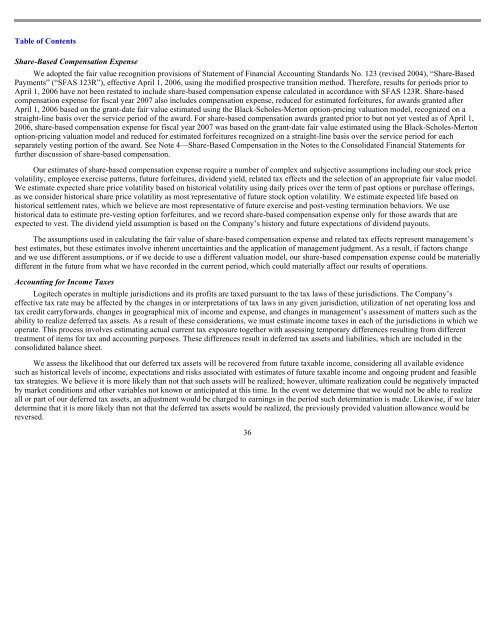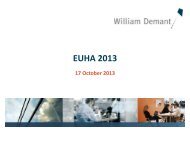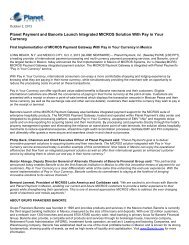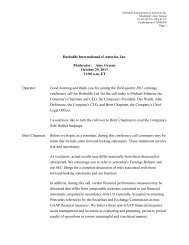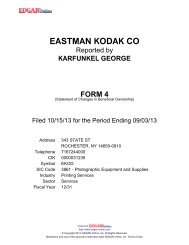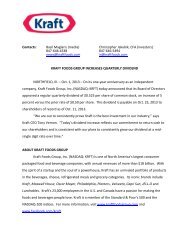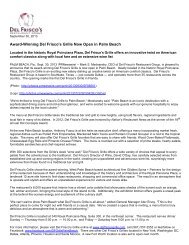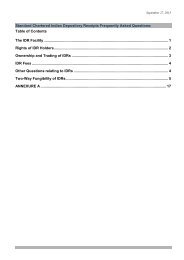LOGITECH INTERNATIONAL SA - Shareholder.com
LOGITECH INTERNATIONAL SA - Shareholder.com
LOGITECH INTERNATIONAL SA - Shareholder.com
Create successful ePaper yourself
Turn your PDF publications into a flip-book with our unique Google optimized e-Paper software.
Table of Contents<br />
Share-Based Compensation Expense<br />
We adopted the fair value recognition provisions of Statement of Financial Accounting Standards No. 123 (revised 2004), “Share-Based<br />
Payments” (“SFAS 123R”), effective April 1, 2006, using the modified prospective transition method. Therefore, results for periods prior to<br />
April 1, 2006 have not been restated to include share-based <strong>com</strong>pensation expense calculated in accordance with SFAS 123R. Share-based<br />
<strong>com</strong>pensation expense for fiscal year 2007 also includes <strong>com</strong>pensation expense, reduced for estimated forfeitures, for awards granted after<br />
April 1, 2006 based on the grant-date fair value estimated using the Black-Scholes-Merton option-pricing valuation model, recognized on a<br />
straight-line basis over the service period of the award. For share-based <strong>com</strong>pensation awards granted prior to but not yet vested as of April 1,<br />
2006, share-based <strong>com</strong>pensation expense for fiscal year 2007 was based on the grant-date fair value estimated using the Black-Scholes-Merton<br />
option-pricing valuation model and reduced for estimated forfeitures recognized on a straight-line basis over the service period for each<br />
separately vesting portion of the award. See Note 4—Share-Based Compensation in the Notes to the Consolidated Financial Statements for<br />
further discussion of share-based <strong>com</strong>pensation.<br />
Our estimates of share-based <strong>com</strong>pensation expense require a number of <strong>com</strong>plex and subjective assumptions including our stock price<br />
volatility, employee exercise patterns, future forfeitures, dividend yield, related tax effects and the selection of an appropriate fair value model.<br />
We estimate expected share price volatility based on historical volatility using daily prices over the term of past options or purchase offerings,<br />
as we consider historical share price volatility as most representative of future stock option volatility. We estimate expected life based on<br />
historical settlement rates, which we believe are most representative of future exercise and post-vesting termination behaviors. We use<br />
historical data to estimate pre-vesting option forfeitures, and we record share-based <strong>com</strong>pensation expense only for those awards that are<br />
expected to vest. The dividend yield assumption is based on the Company’s history and future expectations of dividend payouts.<br />
The assumptions used in calculating the fair value of share-based <strong>com</strong>pensation expense and related tax effects represent management’s<br />
best estimates, but these estimates involve inherent uncertainties and the application of management judgment. As a result, if factors change<br />
and we use different assumptions, or if we decide to use a different valuation model, our share-based <strong>com</strong>pensation expense could be materially<br />
different in the future from what we have recorded in the current period, which could materially affect our results of operations.<br />
Accounting for In<strong>com</strong>e Taxes<br />
Logitech operates in multiple jurisdictions and its profits are taxed pursuant to the tax laws of these jurisdictions. The Company’s<br />
effective tax rate may be affected by the changes in or interpretations of tax laws in any given jurisdiction, utilization of net operating loss and<br />
tax credit carryforwards, changes in geographical mix of in<strong>com</strong>e and expense, and changes in management’s assessment of matters such as the<br />
ability to realize deferred tax assets. As a result of these considerations, we must estimate in<strong>com</strong>e taxes in each of the jurisdictions in which we<br />
operate. This process involves estimating actual current tax exposure together with assessing temporary differences resulting from different<br />
treatment of items for tax and accounting purposes. These differences result in deferred tax assets and liabilities, which are included in the<br />
consolidated balance sheet.<br />
We assess the likelihood that our deferred tax assets will be recovered from future taxable in<strong>com</strong>e, considering all available evidence<br />
such as historical levels of in<strong>com</strong>e, expectations and risks associated with estimates of future taxable in<strong>com</strong>e and ongoing prudent and feasible<br />
tax strategies. We believe it is more likely than not that such assets will be realized; however, ultimate realization could be negatively impacted<br />
by market conditions and other variables not known or anticipated at this time. In the event we determine that we would not be able to realize<br />
all or part of our deferred tax assets, an adjustment would be charged to earnings in the period such determination is made. Likewise, if we later<br />
determine that it is more likely than not that the deferred tax assets would be realized, the previously provided valuation allowance would be<br />
reversed.<br />
36


